Text
Mace is such an awesome multi-faceted character. She’s loyal, she’s courageous, she kicks ass, she’s hot, and she’s a single mother who manages to provide for her son in a horrific political climate. It’s so cool to see such a strong character portrayed by a black woman, working against the typical representation described by Gaines.
Strange Days (1995)
Jane Gaines’s essay “White Privilege and Looking Relations: Race and Gender in Feminist Film Theory” examined the erasure of black women in cinema by white male filmmakers. To fully understand this point, Gaines relies on the history of this topic. Specifically, she states, “If, as feminists have argued, women’s sexuality evokes an unconscious terror in men, then black women’s sexuality represents a special threat to white patriarchy; the possibility of its eruption stands for the aspirations of the black race as a whole” (p. 303). In the film, Strange Days (1995),there is a strong representation of black female empowerment shown in the character of Mace. Initially playing the role of a bodyguard, Mace transforms into a powerful action hero who is constantly saving Lenny from dire situations. In one particular scene, Mace is shown cocking a gun in her holster between her thighs, held under her little black dress. The purpose of this shot is to give Mace a masculine role while still keeping her femininity intact. Tying back to Gaines’s argument, the role of a black female in this film is not to be overlooked, but rather, shown as an independent, kick-ass character. Between the love that Mace has for Lenny and her desire to keep him safe, she is represented in all different lights.

32 notes
·
View notes
Text
It’s interesting how Faith was so hypersexualized and had so very little power over anything, compared to Mace who was not sexualized until she makes the conscious effort to look sexy when she goes to the New Years party to kick ass.
Viewing Response 14: Strange Days (1995)
In Jane Gaines’ “White Privilege and Looking Relations: Race and Gender in Feminist Film Theory”, she argues that women’s sexuality is focused in the experiences and form of the white woman and almost always in the context of man versus female in film. The view of spectators outside of the white heterosexual male gaze is overlooked and not considered. The subject/object conflict between white men and women in film also leaves out large portions of society. Women of other genders and sexualities like lesbians and individuals of other races, in specific black males and females are not considered for their viewing pleasures and relatability to the screen. This idea can be seen in Katheryn Bigelow’s film Strange Days (1995) which reinforces the white heterosexual gaze, even though it was directed by a woman. Though this film does include a strong black female lead, the only sexualized figures in the film were white women and they were present throughout the film. This film also highlighted the subject/ object relationship between Faith and Philo which can be seen in the scene where Lenny approaches Faith and Philo in the club. Philo makes it a point to say that he ‘took’ Faith from Lenny which reinforces the idea that she is an object to be taken. This subject/ object relationship between the males and females is not a gaze that can be related to by groups like lesbians, but plague almost every movie.

6 notes
·
View notes
Text
Strange Days (1995)
In “White Privilege and Looking Relations: Race and Gender in Feminist Film Theory,” Jane Gaines describes how black women tend to be included as a sort of afterthought in film, as if they are just a box to check for inclusivity. A lot of times, a black character (especially a black woman) is in a supporting role and isn’t considered to be the love interest. In Strange Days (1995), Mace’s character breaks this pattern. She is a strong female lead who is just as badass (actually, make that more badass) than her male counterpart. Her blackness is a significant part of the story and is part of how she fits into, and adds levels to, the narrative. It enhances the audience’s understanding of her horror at the atrocities committed by the two cops, as the crime rates are at an all time high and racial divides are incredibly tense. Lenny doesn’t have the words to describe the playback to her because it doesn’t affect him in the same way; his white privilege and background as a cop prevent that. It was a pleasant surprise at the end when the two share a kiss, as she wasn’t his love interest throughout the film. It’s only at the end when Lenny realizes his feelings for this powerful black woman, leading to a underrepresented mixed-race romance. Mace’s character breaks the conventions for black female characters as described in Gaines’s writing.

7 notes
·
View notes
Text
It’s wild how real these characters are and how real the situation they’re in is. We rarely see LGBTQ+ stories that aren’t from a white, affluent, male perspective. It’s really refreshing to see a coming of age story, especially a coming out story, from a different perspective. It’s also kind of refreshing that it doesn’t end in total acceptance. That doesn’t happen in real life all the time. Sometimes parents can’t see past their children’s sexuality, and it’s important to show how that can be dealt with by the child.
Pariah (2011)
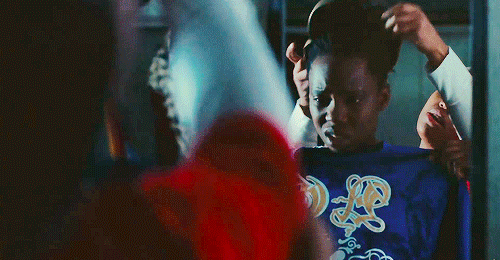
This week we analyzed two texts, Judith Butler’s “Gender Is Burning: Questions of Appropriation and Subversion” and Felly Nkweto Simmonds’ “‘She’s Gotta Have It’: The Representation of Black Female Sexuality on Film, where they discussed how the media portrays both the gender changes on film. In Butler’s text, she states, “places drag on a continuum with cross-dressing and transsexualism, ignoring the important differences between them, maintaining that in each practice women are the object of hatred and appropriation and that there is nothing in the identification that is respectful or elevating.” (Butler, 339) this quote relates to the scene in this week’s movie Pariah (2011) where Lee faces off with her mom. In this scene, Lee’s mom begins to talk down on her daughter to the point of even getting physical with her. This scene shows us how the portrayal of cross-dressing was seen as inappropriate and like she stated well “nothing which is respectful”. This scene shows us how the black community may view cross-dressing and transsexualism as a negative and what image they are trying to portray. Butler agrees with Lee’s statement, she is choosing to go away not running away from her sexuality.
3 notes
·
View notes
Text
It is interesting how you picked a scene contrasting with the reading, but still having the same message. In the reading it says men are the ones who dictate what it means to be woman, even though throughout the film Alike’s dad is the one telling her there’s nothing wrong with her clothes or the way she acts. Her mom is the most offended by her sort of rebellion against femininity and reacts the most strongly.
Viewing Response 13: Pariah (2011)
In this week’s readings, “Gender is Burning: Questions of Appropriation and Subversion” by Judith Butler and “She’s Gotta Have It: The Representation of Black Female Sexuality On Film” by Felly Nkweto Simmonds, discuss the societal views on black female sexuality. In Butler’s text it states “vulnerable to homophobic violence” (Butler 342), meaning that gay people were more often than not, hurt when in conflicting views with straight people. While in Simmonds’ text states, “is the one who tells her whether or not she is a woman and what it is to be a woman” (Simmonds 1), in reference to a male. In this week’s viewing of Pariah (2011), Alike goes through many hardships such as coming out to her parents and finding love. In the last scene we see Butler’s text in how Alike’s mother starts to mentally and physically assault her for being lesbian and a dyke. Due to her mother not tolerating her daughter’s decision, the audience can see the homophobic violence that Butler describes. However, due to her father’s open views he sees her always as his daughter and his mind she will always be a woman. So even with Alike’s coming out, to her father she will always be his child.
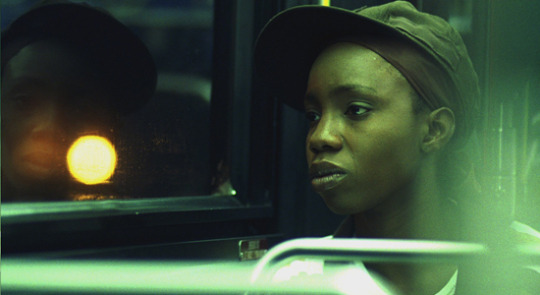
3 notes
·
View notes
Text
This is so true. While watching this scene and a few others, you get sucked in by the events and feel as if you are right there with her, trying to escape the alien. This movie did a great job immersing the audience, unlike some other horror films I’ve seen that may actually make the audience laugh at the ridiculousness of them.
Alien (1979)
In this week’s reading, “Film Bodies: Gender, Genre, and Excess” by Linda Williams we learn of a common thread in the pornographic, horror and melodramatic films of women being portrayed on screen as embodiments of pleasure, fear, and pain. She also touched on how the success of one of these films is measured by, “the degree to which the audience sensation mimics what is seen on the screen”(Williams, 605). In the film “Alien (1979)”, a well renowned horror film, we see how this statement proves itself to be true. In the scene where the character, Ellen, tries to get to the shuttle before the ship self-destructs, but unfortunately runs into the Alien and is forced to stop in her tracks and seize up, is a reaction the audience experiences as well. The audience has been following this character and rooting for her survival, and so once the audience is faced with the possibility of her dying in this scene, the spectator holds their breathe and dares not to move just as the character does, because of the fear and anxiety of what may follow. The effect the film has on the spectator’s bodily response can be seen as somewhat of manipulation, however, it provides proof as to how well the genre was able immerse the spectator into the experience of the character.
youtube
5 notes
·
View notes
Text
I liked that you pointed out how her near nudity creates a feeling of suspense and stress in this context. It’s interesting to think about how the context of nudity and sexualization may change the response from the viewer, and how the sex appeal can be almost overridden by the fear and tension felt by the audience.
Alien (1979)
In Linda Williams text, “Film Bodies: Gender, Genre, and Excess,” she discusses the confusion behind classifying different genres. Specifically, she talks about the “excess” found in porn, horror and melodramas. Even though they remain in separate genres, the need for excessiveness appears in all three. She argues, “in each of these genres the bodies of women figured on the screen have functioned traditionally as the primary embodiments of pleasure, fear, and pain” (p. 605). In the movie Alien (1979),there is a particular scene in which Ripley, the main female character, has finally escaped the main ship and is in the shuttle. While the spectator is still in suspense, Ripley is casually slipping out of her clothes to reveal a small white cropped top and underwear. The next couple of shots sexualize her in an uncomfortable way, because there is still a feeling of anxiety in the room. Williams says, “horror films are excessive in their displacement of sex onto violence” (p. 603). If the spectator was to see a woman undressing, they might become aroused. However, since the context of this was placed in a horror film with a murderous alien on the loose, it conveys stress due to the violent suspense.

2 notes
·
View notes
Text
Alien (1979)
In Linda William’s work “Film Bodies: Gender, Genre, and Excess,” she discusses how women tend to embody pleasure, fear, and pain in the “body genres” horror, melodrama, and pornography. Sex is a commonality between these three genres, but it has different connotations in each. In melodrama, sex is more about experiencing and sharing emotion in a physical way. In porn, sex is basically the whole point and is meant to be arousing for the viewer. In horror, it’s more about vulnerability, evoking a sense of uneasiness in the viewer. In Alien, when Ripley manages to escape the exploding ship and presumably the alien by getting to the shuttle, she undresses and is left in only a tank top and a pretty revealing pair of underwear (I mean really, was that much buttcrack necessary?). When she realizes the alien is in the shuttle with her, she finds herself completely vulnerable. She manages to get into a closet and dress herself in a space suit. Only when she is dressed in this totally non-sexual, non-form-fitting outfit is she felt to be safe enough to return to the main cabin and confront the alien. Sexual motifs in film do not have to just be the physical act; it can also include near-nakedness or suggestive imagery that can provide the same connotation in whichever genre it’s found in.

2 notes
·
View notes
Text
High Noon (1952)
In this week’s reading by Rick Altman, we learn about genre and how it’s defined. A film can be categorized into a genre based on specific characteristics. Altman says, “We can as a whole distinguish between generic definitions that depend on a list of common traits, attitudes, characters, shots, locations, sets, and the like...” for example, the Western genre is defined usually by conflict between an authority and an outlaw, set in an up and coming town out in the new western American territory. There is always a gunfight of some sort, there are always horses, and there is very often a saloon setting. Often, there is a love interest who is captured by the outlaws at some point, usually toward the end, and she is saved by the protagonist. High Noon (1952), is a great example of a classic Western film. It tells the story of an outlaw, recently released from prison, coming back to his old town to exact revenge on the marshall who sent him to hang. The characters all race around town on horses, hang out in the saloon, and worry about the incoming outlaws. The marshall’s wife is captured during a gunfight, but he’s able to save her. This film embodies pretty much all the defining characteristics of the western genre.
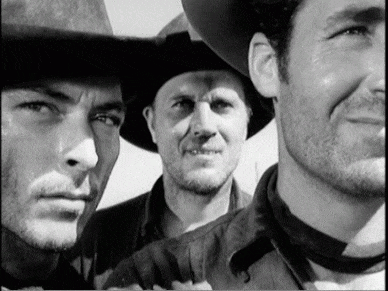
1 note
·
View note
Text
It is really cool how documentaries can provide us with some sort of take away message. Usually people think of documentaries as the boring kind we were forced to watch in middle school and high school, but these highly creative documentaries provide much more well recieved information.
20 Feet from Stardom
In this week’s reading, “The Totalizing Quest of Meaning” by Trinh T. Minh-ha, the use of documentary or how documentary can be constructed can be described as a tool to evoke meaning, depending on what the filmmaker decides to extract and display from in. In the Netflix documentary 20 Feet from Stardom, there was a scene in which Claudia Lennear was speaking on how she was unable to be a successful solo artist and as she spoke, there was an image of a record with her face on it that slowly dissipated to then reveal a plain, blank record cover. This scene speaks to Minh-ha’s theory that in a documentary, “ though the filmmaker’s perception may readily be admitted as being unavoidably personal, the objectiveness of the reality of what is seen and represented remains unchallenged.” This means that although the narrative of the documentary may seem to be leaning toward a more persuasive sense, in that what the filmmaker wants to make apparent is displayed, it can still be taken as an objective informational fact. The image of her face on the record dissolving into nothingness was the filmmaker driving the idea of what she could have been home. This idea is supported by all of her experiences with famous artists, remarking her wonderful voice but just not taking off as a solo artist. Here, the evidence of her star potential is put forth, and the director themselves would have believed this to be true, but even though we as the audience can see that this is the obvious message the director has chosen to relay to us, this idea is irrefutable because of the evidence provided in advance. Documentaries have the power to, while presenting seemingly factual information, also present a meaning and ‘take-away’ that lies deeper within the real life testimonies displayed.

1 note
·
View note
Text
I like how you bring up that even a highly educational film like documentaries can have implied meaning as well as literal meaning. It really sets documentaries up as a creative art form, and a lot of people don’t think of them that way.
20 Feet from Stardom
Trinh T. Minh-ha’s article “The Totalizing Quest of Meaning” delves into documentary films and proposes that their themes are subjective in nature, causing each viewer to have a different perspective and interpretation of the film. Documentaries stand out from their fictional counterparts by offering stories and situations that happened to real people: “It takes real people and real problems from the real world and deals with them. It sets a value on intimate observation and assesses its worth according to how well it succeeds in capturing reality on the run…There are no retakes. The stage is thus no more no less than life itself”(Minh-ha 94). Documentaries are non-fiction and recount true events from a point of view and are extremely diversified. For example, They can deal with real issues and confront problems that are still afflicting the world today, to dealing with an event in a comedic light. As well, this increases the interest of the audience by knowing what is transpiring in the film actually happened to real people. 20 Feet from Stardom, directed by Morgan Neville, is a documentary that followed African American background singers from their careers in the sixties to modern day. One of the scenes that reflected the theme of the film was where Lisa Fischer is singing in her home studio. As she is singing, multiple copies of Lisa begin to surround the microphone, and then slowly fade out one by one. This represents the explosion of female background singers, to the near extinction of them. The documentary reflects how most of the background singers that were covered wanted to have a solo career, but they didn’t have very much financial success despite their talent. The film reflects that life does not slow down or help you, but instead is harsh and difficult. If you want something, you need to have perseverance and a good work ethic, and a bit of luck.
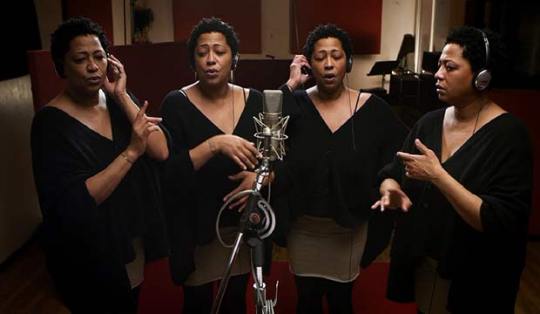
4 notes
·
View notes
Text
20 Feet from Stardom (2013)
This week’s reading, “The Totalizing Quest of Meaning” by Trinh T. Minh-ha, dicusses documentary film and how the presentation of true events in this medium allows for different interpretations. Depending on background and life experience, viewers are able to draw different conclusions about what is presented to them in the documentary. The article also touches on how documentary film tends to shine a light on subjects whose stories often aren’t told, and these subjects may never have brought themselves into the spotlight for whatever reason, intentionally or not. For example, 20 Feet from Stardom is about several background singers who are well known within the industry, but not by the masses. It was interesting to watch a film about these voices we’ve grown up listening to, but never knew who they belong to. The music industry typically tells these background singers that they aren’t that important to fans, so they tended to stay back even more. They are humble, and probably wouldn’t have decided to tell their stories if the documentary maker hadn’t come to them. When Darlene Love recorded a track that was then released under a different band without her permission, she remained humble and quiet. It wasn’t really made a big deal of because it happened way more often than people realized. A lot of people wouldn’t have known this story of a ridiculously messed up producer without this documentary.
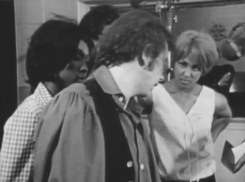
4 notes
·
View notes
Text
Discussion Leader Presentation
Cleo from 5 to 7 (1964)
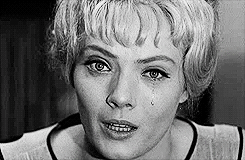
Set in 1960s France, Cleo, a famous singer, has had some medical testing done and is awaiting the results to see if she has cancer. She visits a fortune teller who reads her tarot cards and says that she is ill, but doesn't go further into depth. The film follows her through 5 to 7pm of her day, where she tries to get her mind off of her fear but keeps getting confronted with reminders of impending doom.
youtube
It’s in the Cards
In this opening scene, Cleo is getting her fortune read through tarot cards. The cards are shown in color, but when we cut to Cleo and the fortune teller, they're in black and white. In “Some Points on the Semiotics of Cinema,” Christian Metz describes the difference between connotation and denotation in film and the roles they play in the plot of a narrative. While denotation is the literal meaning derived from visual information, connotation refers to the symbolic or philosophical message of something. Connotation is not obvious, so by nature it changes from viewer to viewer. In this scene, the connotation of the switch between color and black and white to me is that once Cleo gets this news from the cards that she is sick, things turn bleak in her mind and she loses all happiness shown in color.
youtube
No One Cares
In this scene, Cleo goes to a café and plays one of her songs on the jukebox to watch peoples reactions. One woman complains that it makes it hard to concentrate, and another talks about how she doesn’t know how people like it. Immediately after this clip above, Cleo is walking and sees flashes of images of her maid and her composer sitting silently and very still, but in a way that they seem to be confrontational. There’s also an image of a clock. This again ties into connotation, as these collections of images could mean different things to different people. To me, it shows her concern that her friends know about her possible illness, but don’t seem to care. The clock shows her worry that her time is running out, and the café scene shows her that she won't even be survived by her music because these people don't like it.
Monty Python and the Holy Grail (1975)

In this film, King Arthur is rounding up some knights to join his round table. Once he does, God appears before them and sets them on their wild quest to find the Holy Grail.
youtube
Witches Get Stitches
In this scene, the townspeople bring a “witch” to Sir Bedevere the Wise, asking him if they can burn her. It’s very obvious that she is just a regular woman they dressed as a witch, presumably because they don't like her very much. Sir Bedevere asks the townspeople how they know she's a witch and they can’t really give a real answer. This scene is a great example of denotation without accompanying connotation. The only point this scene serves is to establish the fact that Sir Bedevere is the smartest person around and that he would therefore be good on King Arthur’s court. There is really no underlying message to be found anywhere in this narrative, only surface level information that moves the plot in a simple and easy to follow way.
youtube
It’s Not That Deep, Fam. But Maybe it is
In this scene, the knights must answer three questions correctly in order to cross the Bridge of Death and continue their quest. Two of the knights fail and are launched into the Gorge of Eternal Peril. No one is really fazed by this. The deaths of Sir Robin and Sir Gallahad are completely inconsequential and really don't affect the rest of the film in any way. However, one can argue that the circumstance of their deaths hold certain connotations. Sir Robin died because he got cocky about his ability to answer the questions. Sir Gallahad died because he didn't even get his own favorite color correct. These can be seen as warnings to not become too cocky when things get serious and the importance of self-knowledge.
Answer Me These Questions Three
Can you think of any films where connotated meaning prevails over denotated meaning?
Do you think specific genres of film use one over the other? For example, a lot of comedy movies rely more on denotated meaning, like in Monty Python and the Holy Grail.
Are films that rely heavily on connotated meaning more or less successful than films that have a good balance between connotation and denotation?
1 note
·
View note
Text
I love this scene because instead of a male gaze, I’d argue we actually have a female gaze. I know that being a woman viewing this scene, it really felt serene and beautiful to me, a scene of acceptance and love. If the male gaze were applied, this scene would definitely have had a different tone.
Viewing Response 9: Daughters of the Dust (1991)
Director Julie Nash’s Daughters of the Dust features an all-black cast, resembling life on an island in the early 1900s. The struggle to remain to their homeland roots versus traveling up north to start their new life was the prevailing theme throughout this whole movie. bell hooks wrote “The Oppositional Gaze: Black Female Spectators” soon after this film came out. Her thesis includes how the film focused its views on the black female, contradicting the white male. She states, “The impact of racism and sexism so over-determine spectatorship - not only what we look at but who we identify with - that viewers who are not black females find it hard to empathize with the central characters in the movie.” With this phrase, the white presence in film then is left out, and those who identify as white do not understand as clearly.
A scene where this statement that bell hooks described the black female gaze would be the the pregnancy scene. At the 1:11:30 mark, Eula Peazant – Eli’s wife, who was raped by a white man and is now pregnant, is alone in the woods and contemplating her pregnancy. Her husband feels like she has let her down, but she feels satisfied when the entity of her future child runs into her body. Eula feels accomplished, and therefore happy with her child. Because this experience does not happen to the white male, their gaze is not the same of someone who has been in the exact position of Eula.
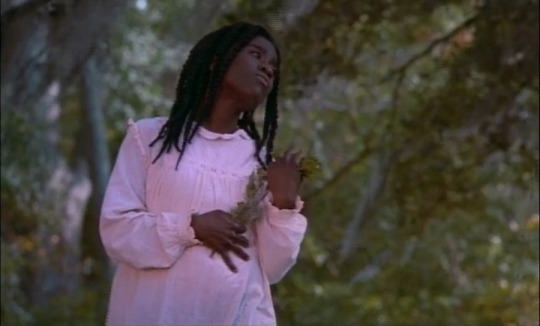
5 notes
·
View notes
Text
It is cool how this film allows for several groups to be recognized and therefore people of those groups able to relate to it. Women, particilularly mothers, can empathize with the pain of a stillborn child. Men can relate to how Eli is feeling about his wife and her predicament. It’s cool how this film recognizes several groups instead of just white men like other films.
Daughters of the Dust (1991)
In this week’s reading of “The Oppositional Gaze: Black Female Spectators” Bell Hooks claims that the lack of African American representation in film eliminates the possibility that black females can have strong roles. It’s no shocker that Hollywood whitewashes films, however, directors historically aim to make the audience relate with the characters. The absence of black female directors contributes to the group having a lack of cinematic presence. Hooks mentions the idea of the “oppositional gaze” this relates to the idea that African American females cannot connect with certain films. The feminist belief of the over objectification of women applies only to white women because black women are never even given a chance to be objectified because of their underrepresentation.
Daughters of the Dust (1991) directed by Julie Dash gives African American women an opportunity to relate to a film. The film features intense background stories for the lives of the women in this family. When Yellow Mary comes back to talk about her stillbirth the viewer feels her sadness and can resonate with her tragedy. This film formats itself with an unusual narrative structure that emphasizes the past present and future. This film relates to the black female spectator which is historically unusual for a film to do as Bell Hooks explains in this weeks reading.
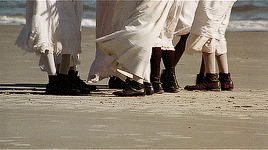
4 notes
·
View notes
Text
Daughters of the Dust (1991)
In this week’s reading, Bell Hooks discusses the underrepresentation of black women in film. Film typically depicts white men geared toward a white male audience. When women are portrayed in the name of progress, they are most always white. Black people are severely underrepresented in film, specifically black women. This underrepresentation lead to an “oppositional black gaze” that forced black people to view film differently, as it is difficult for them to identify with and connect with a film that doesn’t portray anyone relatable to themselves. Hooks says, “it was the oppositional black gaze that developed independent black cinema.” The 1991 film Daughters of the Dust features an all-black, female-centric cast and storyline. In one scene, Eli tells Nana how upset he is about his wife’s rape, as he feels like she no longer belongs to him. Nana quickly reminds him that no woman belongs to anyone but herself, and that he needs to stay in his place as a husband by supporting her. Eula, his wife, gets advice about dealing with unpleasant things from Yellow Mary, who herself was raped but gave birth to a stillborn child. Eula is seen later contemplating her pregnancy, but seems at peace with it. When the spirit of her unborn daughter runs into her body, she grins happily and even excitedly. The stories of these women are not unique through history. Their stories in the context of the film call attention to other stories much like them that white people, especially white men, could not relate to and therefore not completely understand.
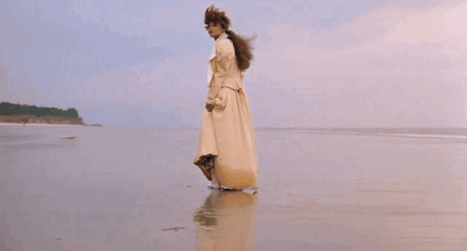
1 note
·
View note
Text
This is a great example of how an image with one denotation can have many different connotations between many different people. It’s good to think about the way someone else may receive an image or idea presented by a film or really any other kind of media.
Do the Right Thing (1989)
In “Some Points on the Semiotics of Cinema,” by Christian Metz, the author speaks about how film can work as language does, through connotation and denotation, and how each spectator can view the same thing differently based on their personal background and experiences which informs their knowledge and views on things. This can be shown in the film “Do the Right Thing,” directed by Spike Lee, in the scene in which the two white policemen slowly drive by three black men sitting on the side walk. The slow motion of the scene and the closeups of all the men’s faces show the disdain that each party felt towards one another. The way this scene was received by the spectator would depend upon who was watching it. Both the white cops and the black men, possessed similar hatred for each other and commented how the other was “a waste.” Depending on where one is from, how they feel personally about police, and other factors varying from person to person, a spectator could view this single scene from either the sides of the policemen or the black men, or simply resonate with one side over the other. The viewer can also see the deeper meaning of the racial tensions escalating in general in that time period, through the intensity of the slow motion shots and close ups in the scene. The viewer can overall sense the tension between both sides through the specific usage if close-up’s and cutting back and forth between each face, a concept also discussed within the reading; the way in which a film is structured informs how it is perceived and a larger meaning.

5 notes
·
View notes